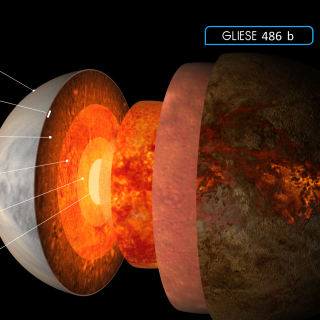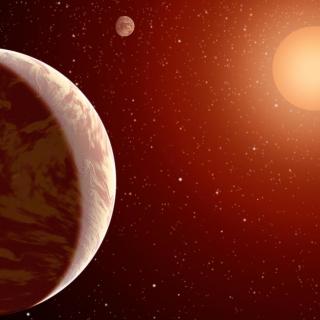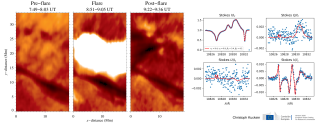Subvenciones relacionadas:
General
La búsqueda de vida en el Universo se ha visto impulsada por los recientes descubrimientos de planetas alrededor de otras estrellas (los llamados exoplanetas), convirtiéndose en uno de los campos más activos dentro de la Astrofísica moderna. En los últimos años los descubrimientos cada vez más numerosos de nuevos exoplanetas y los últimos avances en el estudio de sus atmósferas no sólo están dándonos valiosa nueva información sobre sus propiedades físicas, sino que nos están permitiendo además poner las propiedades de los planetas de nuestro Sistema Solar dentro un contexto más global. El campo esta acercándose al importante descubrimiento de los primeros planetas potencialmente habitables, impulsando estudios más detallados de estos planetas. Con el lanzamiento de las nuevas misiones como JWST, CHEOPS, TESS, ARIEL o PLATO, al campo de exoplanetas se le plantea un futuro muy excitante.
Es por esta razon que este campo se ayuda de y, a su vez motiva, el desarrollo de instrumentación cada vez más sensible y estable tanto para telescopios de tierra como para las misiones espaciales. Dos frentes para los que nuestro grupo esta especialmente preparado. Por un lado, durante los ultimos años hemos desarrollado tecnicas de observacion y reduccion de transitos de exoplanetas para los telescopios del ORM, siendo el nuestro uno de los grupos mas productivos en la explotacion de GTC. Por otro lado, todas las misiones espaciales ESA (presentes y futuras) relacionadas con exoplanetas cuentan con uno o varios de los componentes del proyecto como CoIs.
En el marco de este proyecto, pretendemos que los investigadores del IAC mantengan una situación aventajada con la explotación de OSIRIS y EMIR, instrumentos de primera luz de GTC, y participen en la construcción, comisionado y operación de nuevos instrumentos, como el espectrografo óptico de alta resolución HORUS en el GTC. La explotacion de la fotometria y espectroscopia de transitos con LIRIS en el WHT es tambien uno de nuestros principales intereses, especialmente en preparacion de la instalacion en 2015 del instrumento EMIR en el GTC.
En resumen, el proyecto "Exoplanetas y Astrobiologia" se centrará entorno a estas cuatro lineas principales de actuacion:
1) Caracterización de las propiedades fisicas y atmosfericas de exoplanetas (GTC, WHT, HARPSN, CARMENES, ESPRESSO, ARIEL etc.)
2) Búsquedas y confirmacion de exoplanetas por transitos (CoRoT, Kepler, K2, CHEOPS, XO, LCOGT, WFC, PLATO, etc.)
3) Busquedas/ confirmacion de exoplanetas por velocidad radial (HARPSN, HORUS, LCOGT, SONG, CARMENES)
4) Astrobiología
Miembros
Resultados
- Deteccion de He en la atmosfera de un exoplaneta por primera vez, publicado en Science.
- Deteccion de un planeta entorno a la estrella de Barnard, publicado en Nature
- Deteccion de los primeros planetas del la mision TESS, con varios articulos de impacto
- Descubrimiento de rasgos de Na y Halpha en el espectro de KELT-20b con el TNG
- Publicación del Handbook of Exoplanets, la obra de referencia más extenso en el campo de los exoplanetas. Este Manual fue editado por miembros de nuestro grupo e incluye contribuciones de unos 300 expertos en todo el mundo, incluidos 12 miembros de IAC.
Actividad científica
Publicaciones relacionadas
-
The geometric albedo of the hot Jupiter HD 189733b measured with CHEOPS
Context. Measurements of the occultation of an exoplanet at visible wavelengths allow us to determine the reflective properties of a planetary atmosphere. The observed occultation depth can be translated into a geometric albedo. This in turn aids in characterising the structure and composition of an atmosphere by providing additional information on
Krenn, A. F. et al.Fecha de publicación:
42023 -
A puffy polar planet. The low density, hot Jupiter TOI-640 b is on a polar orbit
TOI-640 b is a hot, puffy Jupiter with a mass of 0.57 ± 0.02 M J and radius of 1.72 ± 0.05 R J, orbiting a slightly evolved F-type star with a separation of 6.33 −0.06 +0.07 R ⋆. Through spectroscopic in-transit observations made with the HARPS spectrograph, we measured the Rossiter-McLaughlin effect, analysing both in-transit radial velocities and
Knudstrup, Emil et al.Fecha de publicación:
32023 -
Glancing through the debris disk: Photometric analysis of DE Boo with CHEOPS
Aims: DE Boo is a unique system, with an edge-on view through the debris disk around the star. The disk, which is analogous to the Kuiper belt in the Solar System, was reported to extend from 74 to 84 AU from the central star. The high photometric precision of the Characterising Exoplanet Satellite (CHEOPS) provided an exceptional opportunity to
Rando, N. et al.Fecha de publicación:
32023 -
A full transit of v<SUP>2</SUP> Lupi d and the search for an exomoon in its Hill sphere with CHEOPS
The planetary system around the naked-eye star v 2 Lupi (HD 136352; TOI-2011) is composed of three exoplanets with masses of 4.7, 11.2, and 8.6 Earth masses (M ⊕). The TESS and CHEOPS missions revealed that all three planets are transiting and have radii straddling the radius gap separating volatile-rich and volatile-poor super-earths. Only a
Barrado, D. et al.Fecha de publicación:
32023 -
TOI-3235 b: A Transiting Giant Planet around an M4 Dwarf Star
We present the discovery of TOI-3235 b, a short-period Jupiter orbiting an M dwarf with a stellar mass close to the critical mass at which stars transition from partially to fully convective. TOI-3235 b was first identified as a candidate from TESS photometry and confirmed with radial velocities from ESPRESSO and ground-based photometry from
Winn, Joshua N. et al.Fecha de publicación:
32023 -
Dynamical masses of two young transiting sub-Neptunes orbiting HD 63433
Context. Although the number of exoplanets reported in the literature exceeds 5000 so far, only a few dozen of them are young planets (≤900 Myr). However, a complete characterization of these young planets is key to understanding the current properties of the entire population. Hence, it is necessary to constrain the planetary formation processes
Zechmeister, M. et al.Fecha de publicación:
32023 -
TOI-836: A super-Earth and mini-Neptune transiting a nearby K-dwarf
We present the discovery of two exoplanets transiting TOI-836 (TIC 440887364) using data from TESS Sector 11 and Sector 38. TOI-836 is a bright (T = 8.5 mag), high proper motion (~200 mas yr -1), low metallicity ([Fe/H]≈-0.28) K-dwarf with a mass of 0.68 ± 0.05 M ⊙ and a radius of 0.67 ± 0.01 R ⊙. We obtain photometric follow-up observations with a
Hawthorn, Faith et al.Fecha de publicación:
42023 -
Temporal albedo variability in the phase curve of KELT-1b
The dayside brightness spectrum of a highly irradiated transiting brown dwarf KELT-1b is challenging to explain based on current brown dwarf atmosphere models. The spectrum has been measured from observations spanning ten years and covering high-precision secondary eclipses and phase curves from space in blue-visible (CHaracterising ExOPlanet
Parviainen, H.Fecha de publicación:
32023 -
TOI-1055 b: Neptunian planet characterised with HARPS, TESS, and CHEOPS
Context. TOI-1055 is a Sun-like star known to host a transiting Neptune-sized planet on a 17.5-day orbit (TOI-1055 b). Radial velocity (RV) analyses carried out by two independent groups using nearly the same set of HARPS spectra have provided measurements of planetary masses that differ by ∼2σ. Aims: Our aim in this work is to solve the
Bonfanti, A. et al.Fecha de publicación:
32023 -
Hint of an exocomet transit in the CHEOPS light curve of HD 172555
HD 172555 is a young (~20 Myr) A7V star surrounded by a 10 au wide debris disk suspected to be replenished partly by collisions between large planetesimals. Small evaporating transiting bodies, that is exocomets, have also been detected in this system by spectroscopy. After β Pictoris, this is another example of a system possibly witnessing a phase
Kiefer, F. et al.Fecha de publicación:
32023 -
The CARMENES search for exoplanets around M dwarfs. A long-period planet around GJ 1151 measured with CARMENES and HARPS-N data
Context. Detecting a planetary companion in a short-period orbit through radio emission from the interaction with its host star is a new prospect in exoplanet science. Recently, a tantalising signal was found close to the low-mass stellar system GJ 1151 using LOFAR observations. Aims: We studied spectroscopic time-series data of GJ 1151 in order to
Blanco-Pozo, J. et al.Fecha de publicación:
32023 -
Early Release Science of the exoplanet WASP-39b with JWST NIRCam
Measuring the metallicity and carbon-to-oxygen (C/O) ratio in exoplanet atmospheres is a fundamental step towards constraining the dominant chemical processes at work and, if in equilibrium, revealing planet formation histories. Transmission spectroscopy (for example, refs. 1,2) provides the necessary means by constraining the abundances of oxygen-
Ahrer, Eva-Maria et al.Fecha de publicación:
22023 -
Early Release Science of the exoplanet WASP-39b with JWST NIRSpec G395H
Measuring the abundances of carbon and oxygen in exoplanet atmospheres is considered a crucial avenue for unlocking the formation and evolution of exoplanetary systems 1,2. Access to the chemical inventory of an exoplanet requires high-precision observations, often inferred from individual molecular detections with low-resolution space-based 3-5
Alderson, Lili et al.Fecha de publicación:
22023 -
Early Release Science of the exoplanet WASP-39b with JWST NIRISS
The Saturn-mass exoplanet WASP-39b has been the subject of extensive efforts to determine its atmospheric properties using transmission spectroscopy 1-4. However, these efforts have been hampered by modelling degeneracies between composition and cloud properties that are caused by limited data quality 5-9. Here we present the transmission spectrum
Feinstein, Adina D. et al.Fecha de publicación:
22023 -
Early Release Science of the exoplanet WASP-39b with JWST NIRSpec PRISM
Transmission spectroscopy 1-3 of exoplanets has revealed signatures of water vapour, aerosols and alkali metals in a few dozen exoplanet atmospheres 4,5. However, these previous inferences with the Hubble and Spitzer Space Telescopes were hindered by the observations' relatively narrow wavelength range and spectral resolving power, which precluded
Rustamkulov, Z. et al.Fecha de publicación:
22023 -
Characterization of a Set of Small Planets with TESS and CHEOPS and an Analysis of Photometric Performance
The radius valley carries implications for how the atmospheres of small planets form and evolve, but this feature is visible only with highly precise characterizations of many small planets. We present the characterization of nine planets and one planet candidate with both NASA TESS and ESA CHEOPS observations, which adds to the overall population
Oddo, Dominic et al.Fecha de publicación:
32023 -
An Earth-sized Planet around an M5 Dwarf Star at 22 pc
We report on the discovery of an Earth-sized transiting planet (R p = 1.015 ± 0.051 R ⊕) in a P = 4.02 day orbit around K2-415 (EPIC 211414619), an M5V star at 22 pc. The planet candidate was first identified by analyzing the light-curve data obtained by the K2 mission, and it is here shown to exist in the most recent data from TESS. Combining the
Narita, Norio et al.Fecha de publicación:
32023 -
The CARMENES search for exoplanets around M dwarfs. Guaranteed time observations Data Release 1 (2016-2020)
Context. The CARMENES instrument, installed at the 3.5 m telescope of the Calar Alto Observatory in Almería, Spain, was conceived to deliver high-accuracy radial velocity (RV) measurements with long-term stability to search for temperate rocky planets around a sample of nearby cool stars. Moreover, the broad wavelength coverage was designed to
Ribas, I. et al.Fecha de publicación:
22023 -
The CARMENES search for exoplanets around M dwarfs. Variability on long timescales as seen in chromospheric indicators
It is clearly established that the Sun has an 11-yr cycle that is caused by its internal magnetic field. Such a cycle is also observed in a sample of M dwarfs. In the framework of exoplanet detection or atmospheric characterisation of exoplanets, the activity status of the host star plays a crucial role, and inactive states are preferable for such
Fuhrmeister, B. et al.Fecha de publicación:
22023 -
The CARMENES search for exoplanets around M dwarfs. Wolf 1069 b: Earth-mass planet in the habitable zone of a nearby, very low-mass star
We present the discovery of an Earth-mass planet (M b sin i = 1.26 ± 0.21 M ⊕) on a 15.6 d orbit of a relatively nearby (d ~ 9.6 pc) and low-mass (0.167 ± 0.011 M ⊙) M5.0 V star, Wolf 1069. Sitting at a separation of 0.0672 ± 0.0014 au away from the host star puts Wolf 1069 b in the habitable zone (HZ), receiving an incident flux of S = 0.652 ± 0
Kossakowski, D. et al.Fecha de publicación:
22023






